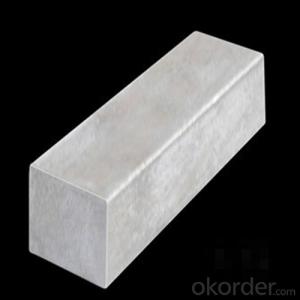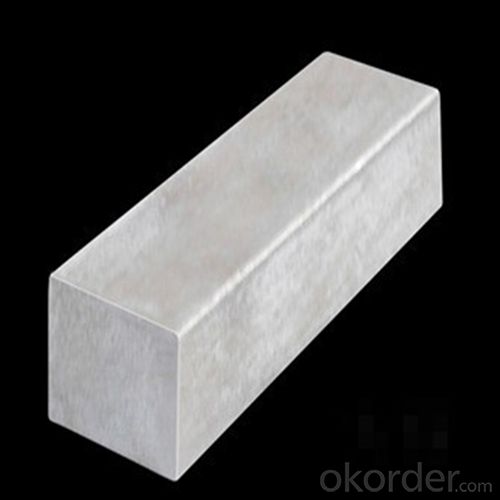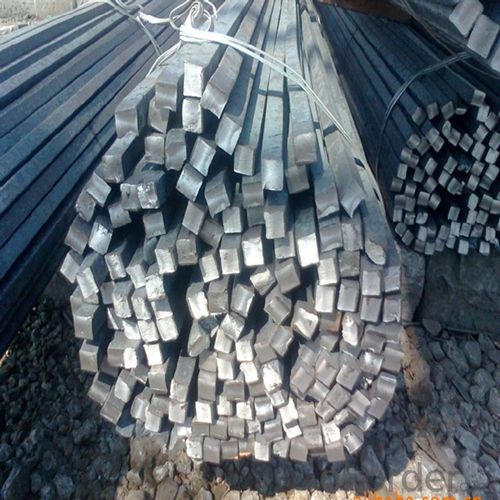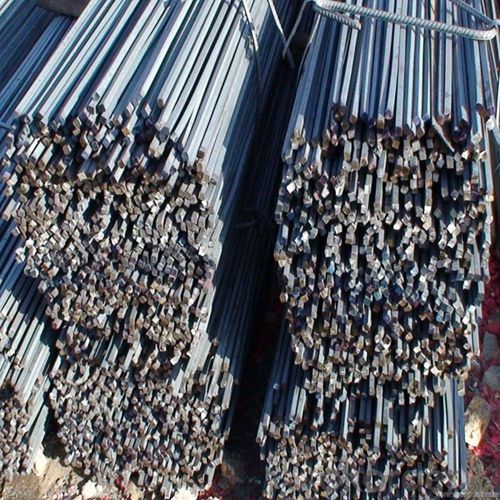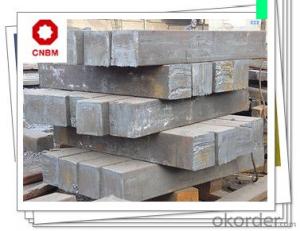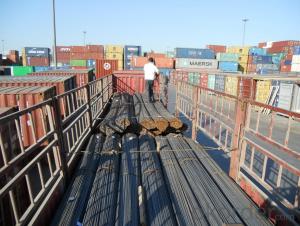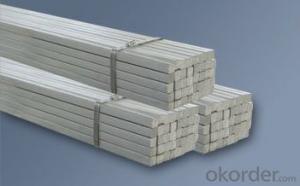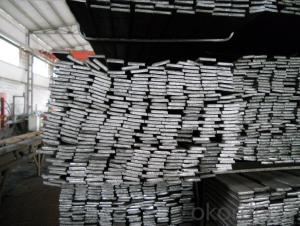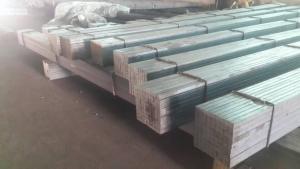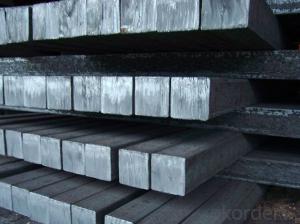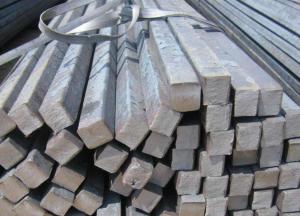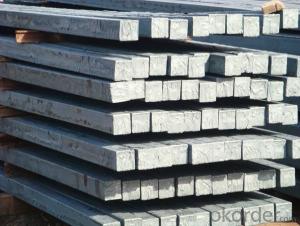Carbon Steel Square Bar for Ship Parts Chinese Standard Q235
- Loading Port:
- Tianjin
- Payment Terms:
- TT or LC
- Min Order Qty:
- 25 m.t.
- Supply Capability:
- 10000 m.t./month
OKorder Service Pledge
OKorder Financial Service
You Might Also Like
1. Structure of Carbon Steel Square Bar description
Carbon steel square bar is a bar with square shaped cross-section. It is special case of equal sides. Before steel products are sold on the market, the steel must first be processed into more functional pieces. Raw steel cannot be of use while in its pure form, thus it has to be cast into shape. The freshly made steel, carbon steel square bar is still in the form of a metal bar or rectangle. Small sizes of carbon steel square bar is used in ship building.
2. Main Features of Carbon Steel Square Bar
• Grade: Q235
• Type: Mild carbon steel
• A quadrilateral with four equal sides and four right angles.
• Vibration: The stiffness and mass are chosen to prevent unacceptable vibrations, particularly in settings sensitive to vibrations, such as offices and libraries.
• Local yield: Caused by concentrated loads, such as at the beam's point of support.
3. Carbon Steel Square Bar Images

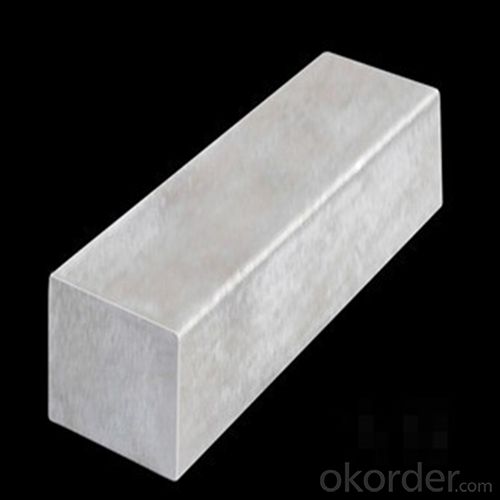
4. Carbon Steel Square Bar Specification
Mechanical Properties | Grade | Steel diameter(mm) | |||
≤16 | 16~40 | 40~60 | 60~100 | ||
Yield Point Δs/MPa | Q195 | ≥195 | ≥185 | - | - |
Q235 | 235 | 225 | 215 | 205 | |
Tensile Strength | Q195 | 315~390 | |||
Q235 | 375~500 | ||||
Elongation δ5% | Q195 | ≥33 | ≥32 | - | - |
Q235 | 26 | 25 | 24 | 23 | |
5. FAQ
We have organized several common questions for our clients,may help you sincerely:
①What is the main material?
There are two types of Square Bar, one is hot rolled square bar and other one is cold drawn square bar. Our principal products is hot rolled square bar. We dedicate to products with material Q195 and Q235. We offer products with high quality and low price.
②How to inspect the quality?
We have a professional inspection group which belongs to our company. We resolutely put an end to unqualified products flowing into the market. At the same time, we will provide necessary follow-up service assurance.
③Is there any advantage about this kind of product?
Steel I beam bar IPE has a reduced capacity in the transverse direction, and is also inefficient in carrying torsion, for which hollow structural sections are often preferred.
- Q: Can a steel square be used for stair layout and construction?
- Stair layout and construction can indeed utilize a steel square. This tool, known by various names such as framing square or carpenter's square, is highly versatile in woodworking and construction tasks, including stair layout and construction. Featuring two arms meeting at a right angle, a steel square possesses a long arm typically measuring 24 inches and a short arm approximately 16 inches in length. This specific design facilitates precise measurements and angle markings, rendering it suitable for stair layout and construction purposes. When employing a steel square for stair layout, it aids in determining the rise and run of each step, as well as the overall stair dimensions. Placing the square against a board or riser's edge enables accurate marking and cutting of required angles and lengths. Beyond layout purposes, a steel square proves beneficial during stair construction as well. It ensures proper cutting and positioning of stringers, which serve as diagonal supports for the steps. By employing the square to mark angles and lengths on the stringers, one can achieve precise and secure cuts, resulting in a robust and well-built staircase. In conclusion, a steel square possesses significant value when it comes to stair layout and construction. Its capability to accurately measure and mark angles and lengths makes it a dependable choice for creating secure and functional stairs.
- Q: Can a steel square be used for metalworking?
- Yes, a steel square can be used for metalworking. Steel squares are commonly used in metalworking to measure and mark angles, ensure accurate cuts, and check the squareness of corners. They are versatile tools that are widely used by metalworkers for various tasks such as layout work, welding, and fabrication processes.
- Q: How do you use a steel square to lay out a irregular polygon shape?
- Before using a steel square to lay out an irregular polygon shape, it is crucial to ensure that the steel square is clean and free from any rust or debris. Afterward, the angles and sides of the irregular polygon that require measurement and marking should be identified. Position one side of the steel square against the edge of the material being worked with. Align the other side of the steel square with the desired angle of the polygon and secure the steel square firmly in place to prevent any shifting during the marking process. Using a pencil or marking tool, create a straight line by carefully marking along the edge of the steel square. Repeat this step for each angle and side of the irregular polygon that necessitates marking. Once all the required lines have been marked, connect the points with a ruler or straightedge to form the shape of the irregular polygon. It is important to note that the accuracy of the layout is dependent on the precision of the measurements and the stability of the steel square throughout the marking process. Regularly inspect the alignment of the steel square to ensure reliable and consistent results.
- Q: Can a steel square be used for cutting wood?
- Indeed, wood can be cut using a steel square. Although its main function is to measure and mark right angles, it can also serve as a guide to facilitate straight cuts with a saw. By positioning the square parallel to the wood's edge, it establishes a reliable reference line for the saw blade to track, ensuring precise and meticulous cuts. Nevertheless, it is crucial to bear in mind that a steel square is not exclusively engineered for wood cutting purposes. Therefore, when utilizing it in this manner, exercising caution and employing appropriate safety precautions is imperative.
- Q: Can a steel square be used for measuring circular objects?
- No, a steel square cannot be used for measuring circular objects. A steel square, also known as a carpenter's square or a framing square, is a tool designed for measuring and marking right angles. It consists of a long straight edge and a shorter perpendicular edge, forming an L-shape. While it can be used for various purposes in carpentry and woodworking, it is not suitable for measuring curves or circular objects. For measuring circular objects, a tool such as a compass, a tape measure, or a set of calipers would be more appropriate.
- Q: Can a steel square be used for checking the squareness of window frames?
- Indeed, the squareness of window frames can be assessed by employing a steel square. The steel square, a multipurpose instrument frequently utilized in woodworking and construction for precision and squareness verification, is composed of a steel blade with a 90-degree angle at one extremity and a handle at the other. When positioning the steel square against the window frame, it is possible to ascertain if the corners are precisely perpendicular or if there exists any deviation from a right angle. Should the steel square fail to align appropriately with the corners, modifications can be undertaken to guarantee the squareness of the window frame before its installation.
- Q: Can a steel square be used for roofing work?
- Roofing work can indeed utilize a steel square. Known by various names such as a speed square or rafter square, this versatile tool finds frequent use in the field of roofing construction. Its purpose is to aid in achieving precise measurements, marking angles, and squaring up roof rafters. The steel square possesses a triangular shape, with its surface adorned with numerous markings and measurements. Typically, it possesses a 90-degree angle, a 45-degree angle, and an assortment of other angle measurements significantly beneficial for roof layout and framing. These angles assist roofers in determining the correct pitch, slope, and alignment of the roof. Besides angle measurements, a steel square also incorporates measurements for common rafter lengths, hip and valley lengths, and other crucial dimensions paramount to roofing. This allows roofers to carry out meticulous calculations and cuts when installing rafters, trusses, and other components of the roof. Moreover, a steel square performs admirably as a straight edge, facilitating the drawing of straight lines and the cutting of roofing materials like shingles or tiles. Its resilient steel construction ensures its reliability and longevity, enabling it to endure the demanding nature of roofing work. To summarize, a steel square proves to be an invaluable tool for roofing work, guaranteeing accurate measurements, precise alignment, and meticulous cuts. Both professional roofers and DIY enthusiasts would greatly benefit from possessing this indispensable tool in their arsenal, ensuring the attainment of high-quality results in their roofing projects.
- Q: Can a steel square be used for checking the squareness of cabinet drawers?
- Indeed, the squareness of cabinet drawers can be assessed using a steel square. Renowned for its versatility, a steel square finds extensive usage in woodworking and carpentry to guarantee precise right angles and square corners. By positioning the steel square adjacent to the corners of the cabinet drawer, one can ascertain its flawlessness in terms of squareness or identify the necessity for any modifications. The straight edges and perpendicular angles of the steel square render it an impeccable instrument for examining squareness and guaranteeing accurate measurements when engaged in cabinet making or other woodworking endeavors.
- Q: How do you check the accuracy of a steel square?
- To check the accuracy of a steel square, there are a few steps you can follow. First, ensure that the edges of the square are straight and free from any dents or damage. Then, place the square against a flat surface, such as a table or a straight edge, and check if all sides of the square are flush against the surface. If there are any gaps or misalignments, it indicates an inaccuracy. Additionally, you can use a straight piece of wood or a known straight edge to verify if the square's 90-degree angle is precise. By performing these checks, you can assess the accuracy of a steel square.
- Q: How do you use a steel square to determine the center of a circle?
- In order to determine the center of a circle using a steel square, you will require a compass, a pencil, and the steel square itself. Follow these steps: 1. Ensure that the steel square is stable and level by placing it on a flat surface or workbench. 2. Adjust the width of the compass to match the diameter of the circle you wish to find the center of. Secure the width by tightening the compass. 3. Position the compass on the steel square, with one leg resting against the inside edge of the square and the other leg extending beyond the edge. 4. Firmly hold the compass and rotate it along the inside edge of the steel square, drawing an arc on the surface below. 5. Repeat this process by rotating the compass along the outside edge of the steel square, drawing another arc that intersects the first one you drew. 6. The point where the two arcs intersect is an approximate center of the circle. 7. To verify the accuracy of the center point, slightly adjust the compass width and repeat the process. The new arcs should intersect at the same point as before, indicating that you have found the true center of the circle. Remember to exercise precision and caution when using a steel square to determine the center of a circle. Utilizing multiple measurements and varying compass widths can contribute to maintaining accuracy in your calculations.
Send your message to us
Carbon Steel Square Bar for Ship Parts Chinese Standard Q235
- Loading Port:
- Tianjin
- Payment Terms:
- TT or LC
- Min Order Qty:
- 25 m.t.
- Supply Capability:
- 10000 m.t./month
OKorder Service Pledge
OKorder Financial Service
Similar products
Hot products
Hot Searches
Related keywords
